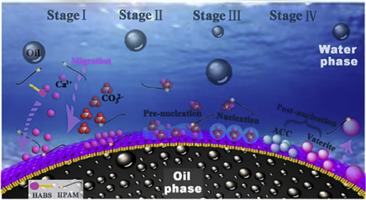当前位置:
X-MOL 学术
›
Powder Technol.
›
论文详情
Our official English website, www.x-mol.net, welcomes your
feedback! (Note: you will need to create a separate account there.)
Interfacial self-propagation of oleophilic vaterite in crude oil emulsion and its application for reinforcing polyethylene
Powder Technology ( IF 4.5 ) Pub Date : 2020-03-01 , DOI: 10.1016/j.powtec.2020.01.041 Weiguang Shi , Zaiqiang Ma , Yuqiang Mu , Jinfeng Wang , Xiaoyang Liu , Zhaohui Dong , Sihan Wang , Mingxing Bai , Zhaogang Teng
Powder Technology ( IF 4.5 ) Pub Date : 2020-03-01 , DOI: 10.1016/j.powtec.2020.01.041 Weiguang Shi , Zaiqiang Ma , Yuqiang Mu , Jinfeng Wang , Xiaoyang Liu , Zhaohui Dong , Sihan Wang , Mingxing Bai , Zhaogang Teng

|
Abstract Non-nature mineral vaterite crystals with lipophilicity are generated in the crude oil migration process, which adversely affects the oil recovery and causes environmental pollution. In this work, a simulated interfacial self-propagating strategy has been designed to obtain quasi hydrophobic and oleophilic vaterite crystals by mixing heavy alkyl-benzene sulfonate (HABS)/Na2CO3/crude-oil emulsion and partially hydrolyzed polyacrylamide (HPAM)/CaCl2/crude-oil emulsion. Oleophilic vaterite is produced through ions migration and self-assembly of nanocrystals at the oil/water interfaces. Monodispersed vaterite spheres were achieved with an average diameter of 2.4 μm, a water contact angle of 88.5°, and a kerosene contact angle of 4.5°. Due to the oleophilic surface, the vaterite has a good compatibility with polyethylene, which exerts an essential role in improving the mechanical properties of polyethylene. This finding enriches the understanding of CaCO3 mineralization in oilfield, and provides new strategy not only for waste-derived application of the vaterite scales but also for organic-inorganic composites manufacturing.
中文翻译:

原油乳液中亲油球霰石的界面自蔓延及其在聚乙烯补强中的应用
摘要 原油运移过程中会产生具有亲油性的非天然矿物球霰石晶体,对采收率产生不利影响,造成环境污染。在这项工作中,设计了一种模拟界面自蔓延策略,通过混合重烷基苯磺酸盐 (HABS)/Na2CO3/原油乳液和部分水解聚丙烯酰胺 (HPAM)/CaCl2/原油获得准疏水和亲油球霰石晶体。 -油乳液。亲油球霰石是通过离子迁移和纳米晶体在油/水界面的自组装产生的。获得了平均直径为 2.4 μm、水接触角为 88.5° 和煤油接触角为 4.5° 的单分散球霰石球。由于表面亲油,球霰石与聚乙烯相容性好,它在提高聚乙烯的机械性能方面发挥着至关重要的作用。这一发现丰富了对油田CaCO3矿化的认识,不仅为球霰石鳞片的废物衍生应用而且为有机-无机复合材料的制造提供了新的策略。
更新日期:2020-03-01
中文翻译:

原油乳液中亲油球霰石的界面自蔓延及其在聚乙烯补强中的应用
摘要 原油运移过程中会产生具有亲油性的非天然矿物球霰石晶体,对采收率产生不利影响,造成环境污染。在这项工作中,设计了一种模拟界面自蔓延策略,通过混合重烷基苯磺酸盐 (HABS)/Na2CO3/原油乳液和部分水解聚丙烯酰胺 (HPAM)/CaCl2/原油获得准疏水和亲油球霰石晶体。 -油乳液。亲油球霰石是通过离子迁移和纳米晶体在油/水界面的自组装产生的。获得了平均直径为 2.4 μm、水接触角为 88.5° 和煤油接触角为 4.5° 的单分散球霰石球。由于表面亲油,球霰石与聚乙烯相容性好,它在提高聚乙烯的机械性能方面发挥着至关重要的作用。这一发现丰富了对油田CaCO3矿化的认识,不仅为球霰石鳞片的废物衍生应用而且为有机-无机复合材料的制造提供了新的策略。































 京公网安备 11010802027423号
京公网安备 11010802027423号